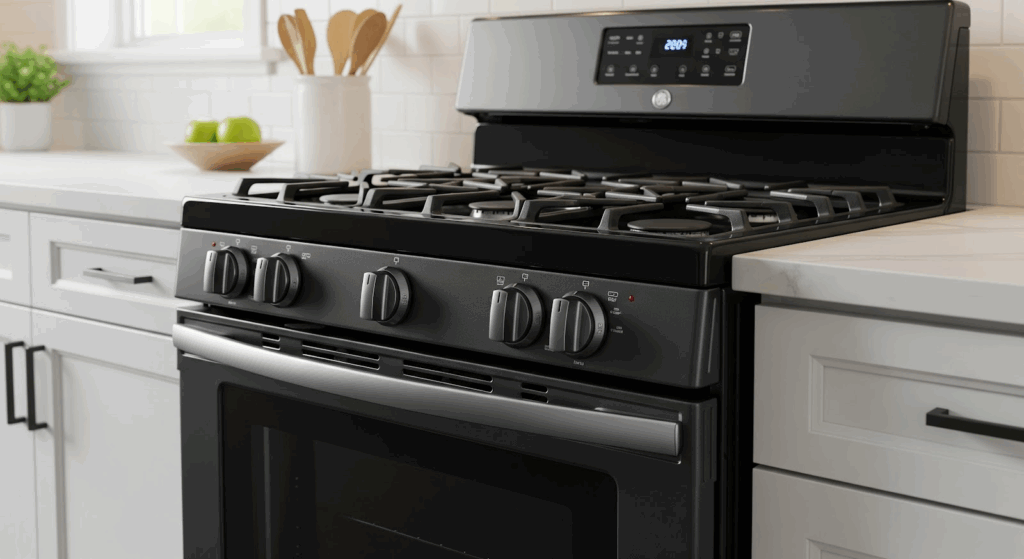
The bake element in your electric GE range is what heats the oven to cook food. Over time, it can wear out or stop working. If your oven isn’t heating evenly, won’t reach the right temperature, or isn’t heating at all, it’s probably time to replace the bake element.
The process is manageable with a few basic tools and some care.
Signs the Bake Element May Be Failing
If you’re not sure whether the bake element is the issue, watch for these signs:
- The oven doesn’t heat up at all
- Only the broil element works
- Uneven cooking or undercooked food
- Visible damage like blistering or breakage on the element
- Hot spots that burn food in specific areas
- Tripped circuit breaker when the oven is turned on
- Strange odors or visible sparks when using the oven
What You’ll Need
- Replacement bake element (make sure it matches your range model)
- 1/4-inch nut driver or screwdriver
Safety First
Keep these safety tips in mind before you begin:
- Cut the power: Unplug the appliance or switch off the breaker. Never work on anything that’s still connected to electricity.
- Let it cool: Wait until the oven is completely cool if it was recently used.
- Clear your space: Work in a well-lit area and remove any clutter. Keep kids and pets away from the workspace.
- Stay dry: Don’t touch internal parts with wet hands, and dry the area before starting.
- Wear gloves: Insulated work gloves can help protect your hands from sharp metal edges.
- Handle parts carefully: Avoid using too much force to prevent damage.
- Take notes or photos: Before disconnecting wires, document how they’re connected to make reassembly easier.
- Avoid contact with exposed wires: Use non-conductive tools or insulated gloves if touching wires is necessary.
- Check the manual: Look for model-specific guidance before beginning the repair.
How to Replace the Bake Element in a GE Electric Range
Here are the steps to replace the bake element in your electric GE range.
- Unplug the range from the power outlet.
- Open the oven door.
- Find the two screws that hold the bake element in place on the back wall of the oven.
- Use a 1/4-inch nut driver to remove the two screws.
- Gently pull the bake element out of the oven cavity.
- Wiggle the bake element slightly if needed to loosen it.
- Find the two wires connected to the bake element and note how each one is connected.
- Disconnect the wires from the bake element.
- Prevent the wires from falling back behind the oven’s interior panel.
- Connect the wires to the terminals on the new bake element.
- Carefully insert the new bake element into the oven cavity by aligning it with the screw holes.
- Replace the two 1/4-inch screws and tighten them using the nut driver to secure the new element in place.
- Close the oven door.
- Reconnect the range power cord to the wall outlet.
- Turn the oven control to the bake function and make sure the new element heats up properly.
What to Do After the Replacement
After the new element is in place, do a few things to check that everything is working as it should:
- Plug the appliance back in or turn the breaker back on
- Turn on the oven and set it to bake at a moderate temperature (e.g., 350°F)
- Watch through the window to see if the element glows red after a few minutes
- Use an oven thermometer to confirm the oven is reaching the correct temperature
- Listen for any unusual sounds, like popping or buzzing
- Check for burning smells—if present, turn off the oven and inspect connections
- Clean the oven floor if any debris fell during installation
- Dispose of the old bake element safely (some metal recycling centers will accept it)
Closing Thoughts
Sometimes your oven gives small hints before it completely stops working—undercooked meals, hot spots, or strange smells. These aren’t random. They usually mean the bake element has worn out. It might sound like a big fix, but replacing this part is something most people can do with a little care and some basic tools. No repair call. No high service fee. Just a simple part swap.
Many don’t realize how often this part goes bad or how easy it is to miss the signs. It doesn’t make noise. It doesn’t look broken at first. It just slowly stops heating the way it should. If you’ve noticed your oven acting differently, it’s a good time to check the element. Remove the screws, take a look at the wires, and put in a new one.
